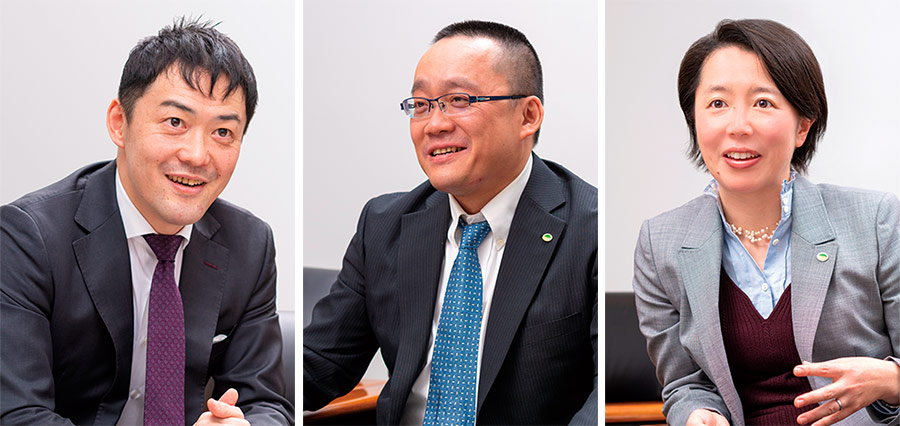IP as Part of Corporate Business Strategy

Makoto Kobayashi
Visiting Professor, KIT Toranomon Graduate School of Innovation Management
Senior Vice President, Deloitte Tohmatsu Financial Advisory LLC
Kobayashi:Interest in intellectual property (IP) landscaping has been rising since an article entitled “Intellectual Property Analysis: Central to Management” appeared in the Nikkei the year before last. In the past, IP departments have used a type of patent information analysis called a patent map, which visualizes the patent portfolios that companies hold. However, whereas IP departments only deal with patent information, this information has been rarely utilized in the business strategies formulated by senior management, resulting in what you might call an information gap. In contrast, IP landscaping that seeks to expand business though innovation has come to be used as a link between IP strategy and business strategy. While I understand that Hitachi is one company where this has been put into practice, what sort of IP information and IP strategies do you actually utilize in business strategy?
Maeda:Hitachi began the practice of preparing IP master plans for each of its businesses from around 2013. In order to reduce business risks and enhance competitiveness based on our business strategy, we analyze IP information, formulate an IP strategy, and add an IP master plan to the business master plan. This has led to results such as winning the imperial prize for the invention of the real-time tumor-tracking radiotherapy system that was created through collaboration with Hokkaido University, for example.
Kobayashi:I understand this has involved effectively incorporating IP information from the beginning, in other words, early-stage business strategy.
Matsuo:However, what we normally call an IP master plan comes into play only after the business strategy is set. The IP master plan analyzes the difference in IP position in the relevant business field and sets a plan to eliminate the difference so as to obtain an advantageous position. In the meantime, I believe IP landscaping refers to certain IP activities that are brought in at an earlier stage or even before the business strategy is set, is that correct?
Kobayashi:That's right. Although having said that, I understand that the past practice of IP landscaping was to only make use of IP information after product planning and development was already underway, meaning that the phase in which IP was introduced was typically later.
Maeda:In this sense, projects involving collaborative creation with customers to build digital solutions have been increasing recently, and because the business plans for these sorts of digital solution businesses tend to be subject to frequent changes, IP is dealt with from the plan preparation stage. In such cases, IP strategy is developed not only for enhancing our competitiveness, but also for establishing business ecosystems with various customers and partners.
Kobayashi:While the pace at which markets and the world at large are changing is accelerating, and there is a need for agile development, significant numbers of manufacturers are not capable of putting it into practice. At Hitachi, what is the IP department doing to facilitate the shift to agile practices?
Maeda:It is fair to say that the IP department gets involved from the early stages of a business, and conversely there are aspects where operational departments are participating in IP strategy from an early stage. As IP strategy is part of business strategy, it is a relevant issue for the operational department staff. Whereas most work on IP dealt with research and development departments or factory engineers in the past, we now encourage front offices to also get involved in IP activities. This is because we cannot develop an IP strategy that takes account of the benefits to the customer without the input of these front offices that act as an interface with the outside world.
Matsuo:Speaking with regard to “agile culture,” I understand that some North American companies proceed with their business strategies while they are aware of the risk of third party IP. In such cases, the IP departments appear to be actively engaging in the building of ecosystems by making software open source or lobbying for law and case changes to create an environment that facilitates agile business practices by reducing IP risk. While our work in the past has mainly involved patent related issues, we are gradually becoming more involved in broader IP-related activities, including IP lobbying, and the creation of ecosystems as well as having an input in business contracts.
Kobayashi:I'm sure IP also has an essential role not only in joining in open source software (OSS) organizations, but also in preparing business contracts in the context of ecosystems and open innovation.
Maeda:Regarding community-based open innovations, in the past, IP departments just assessed the risks and benefits of the rules formulated by the community and did surveys to join the community. More recently, however, we have increasingly been involved in forming new communities, reviewing the community rules from an IP perspective, and working with other community members to finalize them.
Kobayashi:In the case of Open Invention Network (OIN), a consortium of companies that deals with Linux*1 patents, and which made the news last year when Microsoft*2 became a member, the scope of OSS that OIN cares for is extending into areas such as fintech. Given such developments, how do you intend to address OSS in the future?
Maeda:I believe that enthusiasm for opening up IP or making software open source varies between industries. In contrast to the IT industry (which, with software, was an early leader in openness), in the operational technology (OT) industry, there is still know-how that needs to be kept secret within particular companies. Nevertheless, the trend toward openness has been accelerating recently, with greater visibility of factory operation. Hitachi has both IT and OT and I believe that addressing the questions of where to begin opening up and what to keep closed will also be crucial to our Social Innovation Business.
- *1
- Linux is a registered trademark or trademark of Linus Torvalds in Japan and other countries.
- *2
- Microsoft is a registered trademark of Microsoft Corporation in the United States and other countries.
IP Roles in the IoT Era Viewed in Terms of Collaborative Creation

Satoshi Matsuo
General Manager, IP Business Platform Department, Intellectual Property Division, Hitachi, Ltd.
Kobayashi:The companies like Google*3, Apple*4, Facebook*5, and Amazon*6 (GAFA) that operate platforms have been recognized as leaders of the Internet of Things (IoT) era. However, becoming a platform operator like them is not a simple matter. In this respect, I am aware of new possibilities in Hitachi's Lumada. What is your thinking concerning the issues associated with new data that arises from the use of Lumada and new IP that is created as a consequence?
Maeda:One issue that we see as particularly important is the appropriate handling of data entrusted to us by our customers. I believe that the risks associated with handling data must be covered by IP strategy in order to establish trust between our customers and Hitachi in collaborative creation. What is also extremely important is to build win-win relationships with our customers, so that Hitachi can scale its business using collaboratively created solutions. As various different types of IP come into play during the collaborative creation process in the digital solution business, our role has been becoming more important.
Kobayashi:In terms of collaborative creation, though the importance of open innovation has been widely claimed, at this point in time, adequate relationships of trust have yet to be built between startups and venture businesses on one hand and large companies on the other.
Matsuo:That's true. When a venture business wants to participate on an open platform that has been made open source by a platform operator, it is in turn required to make its own software open source. In effect, this allows the platform operator to make free use in their own business of software that incorporates the key technology of the venture business. This has led, recently, to talk about the emergence of venture business resistance to existing platform operators. On the other hand, the platform operators, too, have a case given that many venture businesses, in the development of their own software, make use of resources developed by the platform operators and others over many years that has been made open source. For Hitachi, I believe it will be necessary to establish practices that balance these considerations and also consider the benefits to the venture business when forming partnerships with such businesses or using partnerships to establish ecosystems.
Kobayashi:That certainly makes it important to have a relationship of trust. If we are to complement for each other's weaknesses so as to grow our business, mutual respect will be essential.
Given that the rapid advance of the IoT over the last few years is bringing the businesses of IT and OT companies closer together, what does Hitachi, a company that has both types of technology, make of the strategies of IT companies?
Maeda:The IT industry is building up knowledge about openness, such as what to do to expand open communities and how the consequences of such an expansion will impact back on their own company. I believe it is important to interpret the strategies of IT companies based on the information they make public.
Matsuo:I am interested in what sort of strategy the GAFA companies are following as they steadily file patents in fields like artificial intelligence (AI) and machine learning at the same time as saying they will make the AI software and machine learning software open source. What role will patents play in the future of these fields? If the aim is to use the patents as a form of strong currency in the relevant business, for example, then there is much we can learn.
- *3
- Google is a trademark or registered trademark of Google LLC.
- *4
- Apple is a registered trademark of Apple Inc. in the United States and other countries.
- *5
- Facebook is a trademark or registered trademark of Facebook, Inc.
- *6
- Amazon is a trademark of Amazon.com, Inc. or its affiliates in the United States and other countries.
Scope of IP Activity Inside and Outside Company

Mina Maeda
General Manager, IP Department III, Intellectual Property Division, Hitachi, Ltd.
Kobayashi:I see networks that extend outside the company as being important for IP strategy. This is because access to such networks is essential for acquiring new knowledge and information of IP strategies and practices of leading companies. While IP strategies are often too sensitive to open to the public, there have been an increasing number of cases recently where companies actively announce their IP strategies to the public. Given that Hitachi has established its own network not only with law firms and patent attorneys, but also with organizations such as the Japan Intellectual Property Association, what sort of measures do you take when it comes to establishing external networks?
Matsuo:One example is the work we do on presenting Hitachi's views on and lobbying for regulation and rule-setting. In cases when we are asked to give its views as an industry opinion leader to government inquiries and the like, there are times when, rather than acting solely on Hitachi's own behalf, we make Hitachi's presentation in step with lobbyist organizations. Elsewhere, the European Union (EU) is proceeding with its General Data Protection Regulation (GDPR) as a response to the US platform operators and their global expansion, and Japan, too, has been making moves on data protection through amendments to the Unfair Competition Prevention Act. Our response in cases like these is to express our views from the standpoint of promoting open innovation.
Maeda:During these amendments to the Unfair Competition Prevention Act and the formulation by the Ministry of Economy, Trade and Industry of Contract Guidance on Utilization of AI and Data, Hitachi had opportunities to discuss with external parties with reference to specific examples, including issues that Hitachi had itself come up against. These discussions shed light on the standpoints and concerns of both those who supply data and those who use it, and we learned much from the discussions that Hitachi will be able to utilize in its collaborative creation with customers.
Kobayashi:As the advance of digitalization drives a shift from tangible goods consumption to intangible goods consumption, as well as from owning to sharing, the scope of IP activity is changing and expanding. On the other hand, we should not overlook the cross-divisional function of IP within companies. Along with the links between manufacturing departments and research and development departments, I also see the potential for stronger ties with not just operational divisions and new business planning, but also human resources, legal, and other corporate functions.
Maeda:That is right. While closer cooperation with legal and procurement departments becomes even more important than in the past, cooperation with human resources also becomes a key success factor in terms of education and incentives design to transform our IP strategies and operations.
Matsuo:IP departments are heavily involved in coordinating internal and external matters and many of the people who work there have skills in facilitating discussion, such that they also engage in other activities where they draw on skills acquired from working with IP. As IP staff are good at sorting out complex issues as well as having coordination and analytical skills, in this respect I believe we are able to foster the sort of people who are needed.
Kobayashi:I, too, am conscious of many instances where I am able to draw on my IP experience and know-how. I believe it is fair to say that IP has anticipated the world of the sharing economy, such as cases where one company owns a patent, but it is a different company that puts it to use in business through a licensing or similar arrangement. When one considers the final point of compromise reached through negotiations about where concessions can and cannot be made given the various overlapping expectations and conditions, it also includes highly strategic elements. As the world becomes ever more complex, I expect that the importance of IP experience and know-how, and the people working in the field, will only keep growing.
Maeda:We, too, look forward to taking on new challenges in IP while also supporting the growth of our Social Innovation Business. Thank you for your time today.

